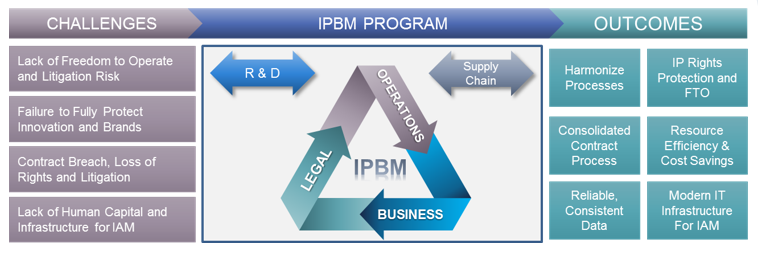
A New IP Operational Paradigm for the 21st Century
The discipline of intellectual property management (“IPM”) continues to mature as a management priority for innovation and brand-driven companies. As intellectual property owners continuously seek ways to improve their IPM strategies, processes and organizations, the need for increasingly capable technology systems drives an increasing and rapidly-paced maturity in business and operational IP Management.
Today, we find the IPM market in the midst of a fundamental paradigm shift, one in which the focus of intellectual property management as an operational discipline matures from its long-understood structural grounding in prosecution towards a more holistic approach to information management that is tightly integrated with the underlying business lifecycle.
The evolution of IPM has materialized like building layers: every ascending floor is built upon the foundation of lower floors. In its initial iteration, the use of IPM systems and technologies centralized on the entry of data, most of which was docketing information and information regarding the prosecution and enforcement of specific intellectual assets—most especially patents. After the widespread adoption of tools that served this data entry model, a new phase emerged in which we sought to expose the information to and involve a wider and more diverse audience. The hallmark of this phase was the increased use of reporting and business intelligence, which gave supervisors, legal management, business leaders and other key stakeholders access to important – and timely – data on the status of assets and the performance of the portfolio. This phase of IPM’s growth also emphasized tools for collaboration among corporate teams, law firms, and other parties involved in the IPM lifecycle, for automating routine processes (a measure of both the drive to efficiency and increasing legal cost and rate pressures), and for the capture and management of innovation and assets.
To illustrate this new maturity plane in IP Management, we introduce a new term of art to capture this paradigm shift: Intellectual Property Business Management (IPBM). It is no longer sufficient to manage – nee understand – IP from a purely legal perspective, or on an asset-to-asset basis. Organizations today are now keenly interested in the impact of their IP portfolio have on their business, and vice versa. Notably, IPBM is characterized by an increased demand for greater bottom-line visibility, for insight into operations and performance, and for demonstrable improvements in practice management. In essence, the broadening scope of integrated stakeholders and alignment of interdepartmental interests demonstrates a shift in IPM from a prosecution-based lifecycle to a business-integrated lifecycle. Through the lens of IPBM, the role and effect of people, process, organization and technology within the IP operation are all essential, and data entry and access are frequently commoditized. The overarching driver and objective of IPBM is the support of core business operations, revenue generation and corporate value with a robust data-driven decision-making program.
IPBM: Models, Processes and Technologies
IPBM is about broadening an IP operation’s capabilities to align strategy, process and organizational dynamics. One vendor representative we spoke to in our research captured the vision of IPBM well: “Operationalizing insight.” Such operationalization relies heavily on involving a greater number of departments and decision-makers in the analysis of how to turn that insight into strategic action. In other words, the IPBM model builds on those layers of perspective and nuance to inform IP-related decision-making with broader business context and execution capabilities.
The model for IP Business Management (Fig. 1 below) defines the central role IPBM plays in addressing core asset management challenges to drive positive outcomes. As the model details, the central tenet of IPBM is the integration and alignment of the organization’s legal, operational and business processes to identify, address, mitigate and resolve the challenges of IP. IPBM defines a maturity scale characterized most notably by understanding these challenges as multifaceted and interdepartmental, and absolutely core to organizational value. IPBM, thus, presents a unique set of opportunities to impact value through better innovation, revenue, risk management and cost savings. From a more tactical perspective, though IPBM is defined strategically, it serves first to align core organizational competencies and then deliver efficiencies in the way it defines, monitors and supports everyday processes that focus on the capture, nurturing and management of the organization’s innovation assets. Among the goals are increased transparency and a clearer understanding of how the activities of one set of stakeholders could—or should—affect the outcomes of another set of stakeholders.
Fig. 1 IPBM: An Illustrative Model

IPBM can also be seen as a continuous business process. It is a process built as much on strategic inputs as it is on the tactics of innovation management, protection and commercialization.
To further explore this concept, the flow chart in Fig. 2 below represents a loop defined by four phases: Needs, Growth, Maintain and Realize. This chart visualizes the progression from traditional IPM, which largely focused on—and was limited to—innovation management and IP prosecution (the “Growth” phase in the chart below) to a more dynamic, interactive means of strategic business management. As such, the IPBM Lifecycle demonstrates the importance of aligning business and strategic objectives in the inputs (Needs), the outputs (Growth) and commercialization of innovation
Fig. 2 IPM as a Continuous Business Process—A Lifecycle

The Needs component (Fig. 2 above) is where decisions that drive the IP lifecycle intersect with the businesses that drive creation, and where decisions driving business-related outcomes are made. We can refer to this dynamic colloquially as the “businessification of law.” Yet this evaluation of strategy, positioning and the competitive landscape is linked explicitly to the identification of opportunities and the defense of assets and value. IPBM is dynamic, repeatable and evolutionary by design.


